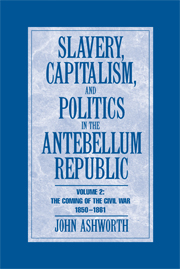Book contents
- Frontmatter
- Contents
- Acknowledgments
- Introduction: Explaining the Civil War (1)
- Part I Slavery versus Antislavery
- 1 Combating the weaknesses of slavery: Southern militants, 1850–1861
- 2 The antislavery challenge: The Republicans, 1854–1861
- Part II Polarisation and Collapse
- Conclusion: Explaining the Civil War (2)
- Appendix: A review of some major works on the reasons for Confederate defeat
- Index
1 - Combating the weaknesses of slavery: Southern militants, 1850–1861
Published online by Cambridge University Press: 05 June 2012
- Frontmatter
- Contents
- Acknowledgments
- Introduction: Explaining the Civil War (1)
- Part I Slavery versus Antislavery
- 1 Combating the weaknesses of slavery: Southern militants, 1850–1861
- 2 The antislavery challenge: The Republicans, 1854–1861
- Part II Polarisation and Collapse
- Conclusion: Explaining the Civil War (2)
- Appendix: A review of some major works on the reasons for Confederate defeat
- Index
Summary
Introduction: The weaknesses of slavery
On March 4, 1850 John C. Calhoun of South Carolina entered the Senate to present his last great speech. He had been for almost twenty years the leading, though not always the most extreme, exponent of the view that the South must awaken to the dangers of abolition, must unite to demand her rights under the Constitution, and must, if those rights were not granted, be prepared to secede from the Union. As soon as it was known that the South Carolinian was to speak, queues formed on Capitol Hill. In fact Calhoun had less than a month to live and his speech had to be read by James Mason of Virginia. Nevertheless, it was listened to, one onlooker reported, “with the deepest attention.”
By 1850 Calhoun's warnings had acquired fresh urgency in the minds of many southerners. The huge accession of territory (covering California, Nevada, Utah, most of New Mexico and Arizona, and parts of Oklahoma, Wyoming, Colorado, and Texas) that followed the nation's triumph in the recent war with Mexico had reintroduced the question of slavery in the territories. Large numbers of northerners had in the late 1840s rallied behind the proviso which bore the name of David Wilmot and which sought to exclude slavery from these newly acquired lands. Most southerners regarded the Wilmot Proviso as an outrageous violation of their equal rights within the Union and for Calhoun it was confirmation, if any were by now needed, that antislavery sentiment in the North had attained fearsome proportions.
- Type
- Chapter
- Information
- Slavery, Capitalism and Politics in the Antebellum Republic , pp. 13 - 172Publisher: Cambridge University PressPrint publication year: 2007



